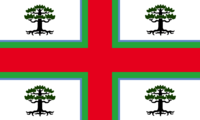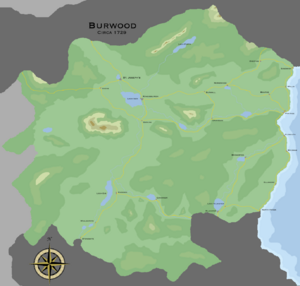Burwood: Difference between revisions
No edit summary |
No edit summary |
||
| Line 17: | Line 17: | ||
== History == | == History == | ||
The region of Burwood was originally established by [[Nova England]] around 1500 AN, who began to rapidly colonize the area. But by 1551 the Nova English had been pushed back by hostile tribes towards their cores lands in the north. Eventually Burwood would be occupied by [[Sirocco]], and later on Ergonia. Although Nova England would resurface again, they would never reassert control over Burwood before their eventual collapse. The arrival of [[Norse]] settlers from the east around 1700 caused a series of conflicts with the long-established locals, as the emergent state of [[Ostland]] began to forcibly convert the population to their culture. Lacking the firepower to resist, the locals were subjugated as Ostland's power radiated from Reichsborg to the shores. | The region of Burwood was originally established by [[Nova England]] around 1500 AN, who began to rapidly colonize the area. But by 1551 the Nova English had been pushed back by hostile tribes towards their cores lands in the north. Eventually Burwood would be occupied by [[Sirocco]], and later on Ergonia. Although Nova England would resurface again, they would never reassert control over Burwood before their eventual collapse. The arrival of [[Norse]] settlers from the east around 1700 caused a series of conflicts with the long-established locals, as the emergent state of [[Ostland]] began to forcibly convert the population to their culture. Lacking the firepower to resist, the locals were subjugated as Ostland's power radiated from Reichsborg to the shores. Ostland's colonialist policies would come to a halt with the start of the [[Burwood Wildfires]]. As Ostland collapsed, Moorland assumed authority over the region and restored the Council of Burwood. Reversing years of Norse colonialism, a new government was formed encompassing elements of the remaining Ostlandic people and the Nova English population. While a new capital was established as St. Joseph's, the gutted ruins of Reichsborg were slowly being rebuilt as the city of Kingsburgh. | ||
== Geography == | == Geography == | ||
The territory of Burwood is mostly rural woodland. It is punctuated by several large highland areas that are covered in evergreen forests, mostly Moors Pine. Four large lochs feed freshwater rivers, and it is along these and the coastline where most of the population is concentrated. | |||
[[File:Burwood-map.png|left|thumb|Map of Burwood, circa 1729]] | [[File:Burwood-map.png|left|thumb|Map of Burwood, circa 1729]] | ||
[[Category:Moorland]] | [[Category:Moorland]] | ||
Revision as of 20:35, 1 February 2024
| Burwood | |
| Subdivision type: | Council |
| Capital: | St. Joseph's |
| Population: | 441,302 |
| Largest Cities: | St. Joseph's |
|
| |
| Local Leadership Title: | Exarch |
| Local Government: | Witan |
| Current leader: | Bernard MacGrath |
|
| |
| Local language: | East Moorlandic |
| Local Religion: | Church of the Holy Lance |
Burwood is a council territory of the Kingdom of Moorland. The region is the encompasses the majority of old Ostland. It was created following the Burwood Wildfires, which gutted most of the region's population and destroyed thousands of acres in Burwood Forest. The capital is St. Joseph's, a small city that was rebuilt following the destruction of Reichsborg a short distance to the east. The Burwood Restoration Initiative is a government-funded project to rebuild the region following the fires.
History
The region of Burwood was originally established by Nova England around 1500 AN, who began to rapidly colonize the area. But by 1551 the Nova English had been pushed back by hostile tribes towards their cores lands in the north. Eventually Burwood would be occupied by Sirocco, and later on Ergonia. Although Nova England would resurface again, they would never reassert control over Burwood before their eventual collapse. The arrival of Norse settlers from the east around 1700 caused a series of conflicts with the long-established locals, as the emergent state of Ostland began to forcibly convert the population to their culture. Lacking the firepower to resist, the locals were subjugated as Ostland's power radiated from Reichsborg to the shores. Ostland's colonialist policies would come to a halt with the start of the Burwood Wildfires. As Ostland collapsed, Moorland assumed authority over the region and restored the Council of Burwood. Reversing years of Norse colonialism, a new government was formed encompassing elements of the remaining Ostlandic people and the Nova English population. While a new capital was established as St. Joseph's, the gutted ruins of Reichsborg were slowly being rebuilt as the city of Kingsburgh.
Geography
The territory of Burwood is mostly rural woodland. It is punctuated by several large highland areas that are covered in evergreen forests, mostly Moors Pine. Four large lochs feed freshwater rivers, and it is along these and the coastline where most of the population is concentrated.

